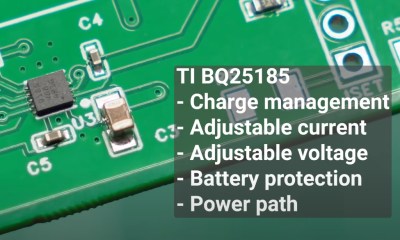The TP4056 is the default charge-controller chip for any maker or hacker working with lithium batteries. And why not? You can get perfectly-functional knockoffs on handy breakout boards from the usual online sources for pennies. Betteridge’s Law aside, [Lefty Maker] thinks that it may well be time to move on from the TP4056 and spends his latest video telling us why, along with promoting an alternative.
His part of choice is another TI chip, the BQ25185. [Lefty] put together his own charge controller board to show off the capabilities of this chip — including variable under- and over-charge protection voltages. Much of his beef with the TP4056 has less to do with that chip than with the cheap charge modules it comes on: when he crows about the lack of mounting holes and proper USB-PD on the knock-off modules, it occurs to us he could have had those features on his board even if he’d used a TP4056.
 On the other hand, the flexibility offered by the BQ25185 is great to future-proof projects in case the dominant battery chemistry changes, or you just change your mind about what sort of battery you want to use. Sure, you’d need to swap a few resistors to set new trigger voltages and charging current, but that beats starting from scratch.
On the other hand, the flexibility offered by the BQ25185 is great to future-proof projects in case the dominant battery chemistry changes, or you just change your mind about what sort of battery you want to use. Sure, you’d need to swap a few resistors to set new trigger voltages and charging current, but that beats starting from scratch.
[Lefty Maker] also points out some of the advantages to making your own boards rather than relying on cheap modules. Namely, you can make them however you want. From a longer USB port to indicator LEDs and a built-in battery compartment, this charging board is exactly what [Lefty Maker] wants. Given how cheap custom PCBs are these days, it’s not hard to justify rolling your own.
The same cannot be said of genuine TI silicon, however. While the BQ25185 has a few good features that [Lefty Maker] points out in the video, we’re not sure the added price is worth it. Sure, it’s only a couple bucks, but that’s more than a 300% increase!
We’ve seen other projects pushing alternative charge controllers, but for now the TP4056 reigns as the easy option.

















>perfectly-functional
>knockoffs
pick one.
Exactly. Every time Hackaday praises a cheaper knockoff chip/board this is what I think of. It might not always be true, but it sure almost always is.
It’s a coarse and tiny chip that can easily be reliably manufactured in bulk.
And I don’t recall anybody ever wail about a Chinese 4056 board failing.
Even though people seem to be so eager to complain about China, to the point that you think Trmp should lower the propaganda budget as part of his savings. (especially since the EU and UK will pick up any slack…)
But do you have proper tools to validate the functionality of the chip every time? Because in the end it is the only thing that matters.
If you don’t, only option to reduce probability of a disaster is a trustworthy supply chain.
If odds of failure is 1/1 000 000 000 and you build 100 units, you are already at 1/10 000 000. And what if an unknown cheap knockoff unknown manufacturer does the same calculations they might see a lot of potential to reduce the costs and increase profits.
I’ve seen a lot of recalls of power banks from big name brands in last 5 years. Yeah those all might be connected to internal structure or anything similar. Might. And the odds are on the table again.
Consequences of lithium ion battery going off at your home when you sleep might be bit too much for anyone.
The power banks are rarely recalled for electronics issues, it’s usually poor construction (loose wiring etc) or shoddy batteries.
The recent Anker recall is apparently because the positive & negative electrodes are too close together. This is similar to the infamous Samsung Note 7, that had the bonus fault of the battery maker occasionally skipping the kapton tape to speed up production.
I’m surprised the TP4056s don’t fail more often, they do get a bit toasty when you put an amp (max charge) thru them. I’ve never seen one fail, linear regulators for the win!
Yeah, I suppose one needs to learn the hard way bad before realising that using knockoffs has its risks and when they realise the price difference to genuine parts is absolutely nothing.
I only burned a batch of microcontrollers (and weeks figuring out and waiting genuine components and months with final implementation because location was 150km away) with a hobby project when a knockoff regulators had undocumented features like 20-30% smaller maximum voltage compared to genuine ones in roughly 20-30% of the batch based on later tests.
But it baffles me that people are doing that with lithium battery charging related stuff. Like what could go wrong with lithium batteries…
I will abandon the TI BQ25185 for my future projects starting of next year.
Why? End of the year the TI BQ25630 will be released which has an integrated ADC that can sample all relevant voltages and currents of the power chain.
Also it has a lot of settings which can be configured via I2C.
End of the year the BQ BQ25630 is coming up. It’s a 1-cell-charger which has a DCDC design and also an integrated ADC which is able to sample all currents and voltages along its power chain.
Maybe the other chip has some nice things, but one of the good points of the 4056 is the easy of soldering ( admitedly, I didn´t look it 25185 is available in other encapsulation.
But, as per the article, he complains about the “cheap charge modules”. Well, the 25185 will also be in cheap charge modules, so not much help here.
The TP4056 will only be retired when someone manages to make a jellybean switchmode charger instead.
That turns out to be more complicated than it first seems. You pretty much need comparatively expensive off-chip passives. And how do you decide the operating frequency, manage EMI, etc. Hence why we’re all still accepting the losses of linear charging, usually from 5V. If you drop 5V down to ~2.7V at 1A you burn 2.3W with only 2.7W of the consumed 5W going to the battery, it’d be nice to do better than that.
There’s the Texas Instruments BQ25125 it’s only 300ma but it’s switched mode with i2c programmable voltage/ current and other options
Set-and-forget jellybean charging modules are all set with pulling pins high/low with solderpads.
Throwing i2c into the mix complicates things, often even too much for said modules to become popular in the first place.
Yeah, you want to run far from any of TI’s reconfigurable battery management chips unless you’re a masochist, you have a tonne of money and time, or you have no choice.
They’ve long been a fan of such misfeatures as “only compatible with our $1000 i2c-adapter-in-a-trenchcoat”, “only configurable with our shitty VB app”, and “will be permanently hard-bricked if you look at it wrong”.
Reminds me of the agony of repurposing “hot swap” laptop batteries.
Where at the end of the day, the easiest and sane solution is to only harvest the cells.
Betteridge’s Law-compliant headline: “Should we suffer the TP4056 to live?”
Huh. I should have double checked that; I was sure that part started with TI before getting cloned in China, but a quick google reveals no evidence of that. Good catch, thanks!
I’ll correct the article.
It’s been time to retire the TP4056 all along. I’ll explain why: It has no option to charge to anything other than 100%.
Most small devices have enough room for a battery with 3x the capacity, and they are so small the larger capacity battery doesn’t cost appreciably more, say a few pennies or 50 cents more, and sometimes it’s cheaper or free if you use harvested cells.
If you used a battery with 3x the capacity and only used it between 15 and 85% for example it would extend the number of cycles by hundreds more, also you would still have roughly double the capacity you did.
Since the TP4056 only charges to 100% you cannot design any long term solutions, only ones with the minimum battery life-span.
I’m honestly surprised there aren’t some robust homebrew methods to do this on an Atmega or similar processor. Or even with discrete chips. As far as I know the CC charge mode wouldn’t even be needed if you only charge to ~90%, and being able to set the cut off at ~20% would greatly prolong the battery.
So yeah, Boo TP4056. I use something like it to jump start packs or do a manual balance sometimes.
i agree with our point but
if you have 3x the capacity, then each cycle lasts 3x as long. if your capacity is much larger than you need, then you basically never have to charge. for example, i have a few projects using MAX1555 (even more primitive than TP4056) that i charge about once a month. so i don’t care if it lasts 100 cycles or 1000 cycles because in fact i’m going to charge it at most dozens of times before it fails from age instead of use.
of course it’s a different story if you are leaving it on standby charging 24/7
I was rummaging around for a datasheet and found the BQ25150
It is configuable over I2C and has a built in linear regulator! Wow, crazy stuff.
Another reason not to use the TP4056: Every one of the cheap Chinese modules have a design flaw in that they can overcharge a cell without protection. You’re supposed to disconnect from the load while charging.
https://www.best-microcontroller-projects.com/tp4056.html
Whoops I didn’t mean to reply to you but make a new comment.
That specific link is wildly inaccurate, and I’ve called it out before on HaD. I’d strongly suggest forgetting you ever saw it, because the whole “disconnect from the load while charging” thing is garbage, and their reasoning is completely erroneous.
Sorry to make you repeat yourself but could you at least copy+paste what you said? I searched the entire site for your username and TP4056 and only came up with one comment two years ago which didn’t explain your reasoning here.
Found your comment:
https://hackaday.com/2022/10/10/lithium-ion-battery-circuitry-is-simple/#comment-6520067
No! is not time yet because… I have never used it :) I’m still struggling with the lm555 :) and the legend says there is a beast called 556 go figure!
I think we need to remember batteries are not as delicate as most people believe.
An LM341 is just as good at charging cells as a 4056 or any linear charger
No! The TP4056 isn’t a linear charger, and nor is any commercial lithium-ion charging device. Where did you get that crazy idea?
They’re almost always using a CC-CV charge profile, with various under/over voltage and temperature protection mechanisms, and often a low-charge preconditioning step. You’re not doing that with an LM341.
You’re not wrong that Lithium-ion batteries aren’t delicate if you treat them properly, but rolling your own circuit when you’re under the misconception that “they’re all just linear supplies” is a quick route to mistreating them.
Leadless packages are a pain to solder, especially on a home made PCB with no solder mask. I will be sticking with the TP4056 since it now costs a fortune to have a PCB made.